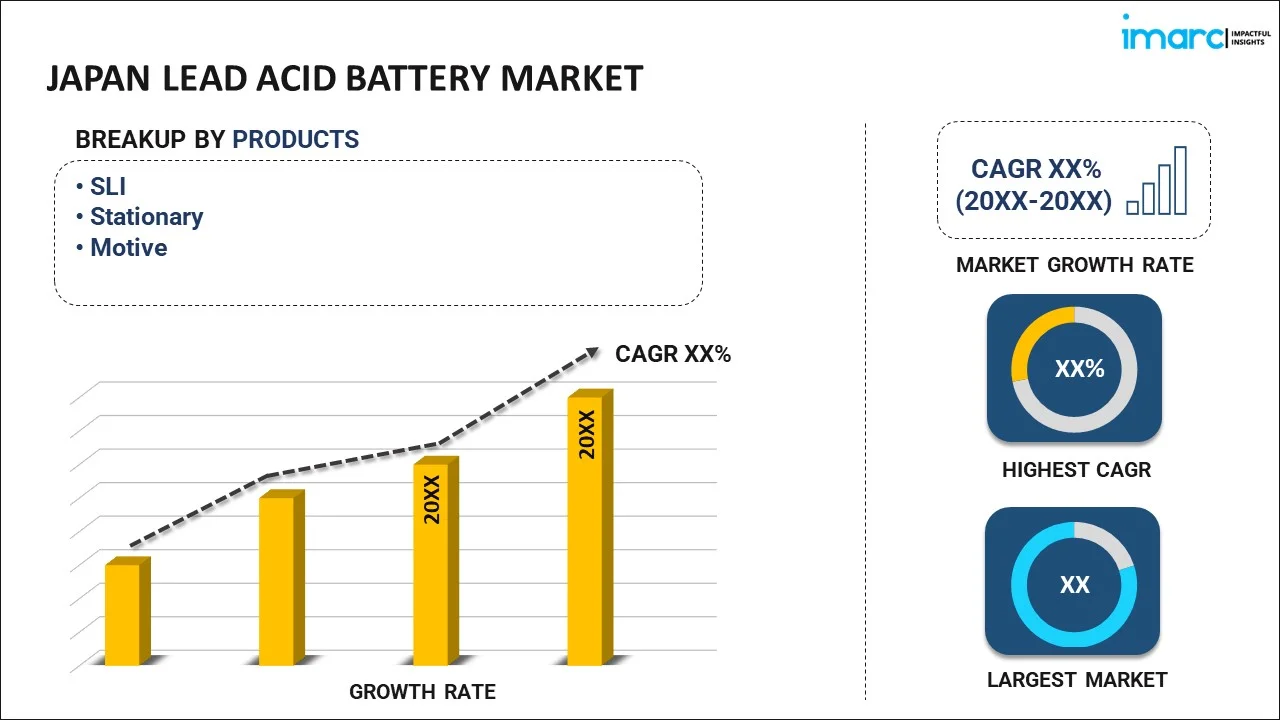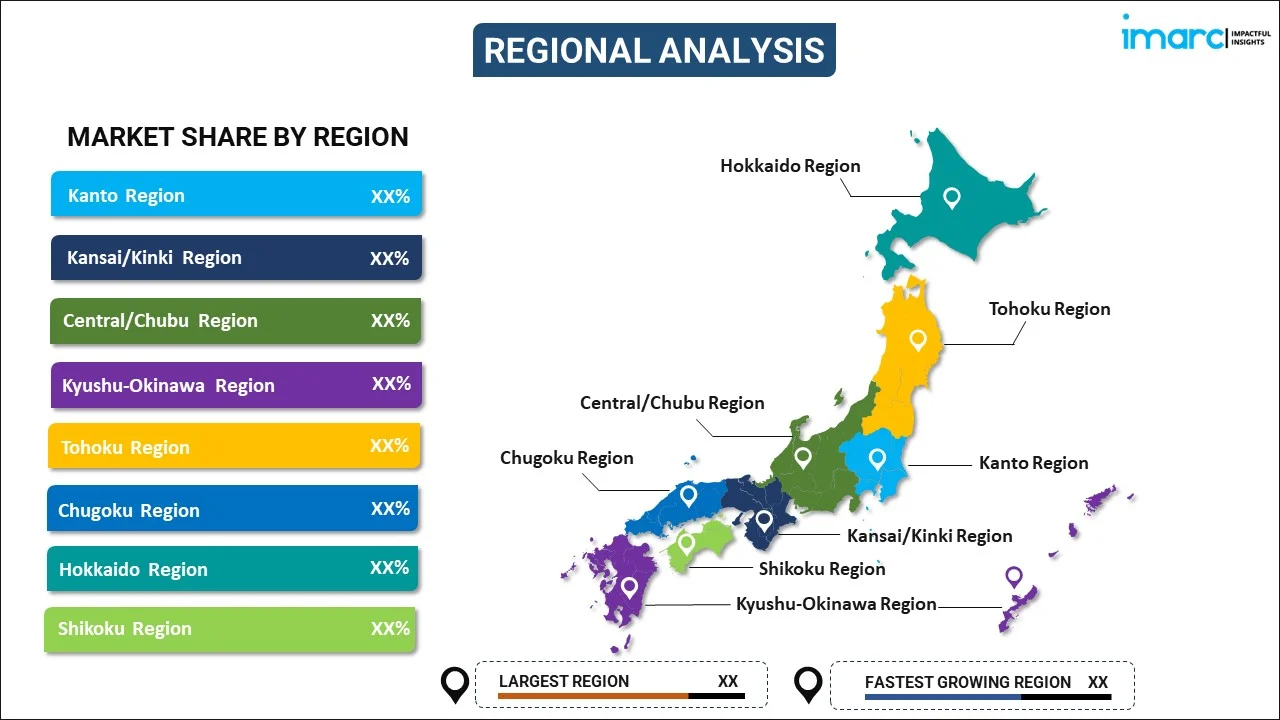
Japan Lead Acid Battery Market Report by Product (SLI, Stationary, Motive), Construction Method (Flooded, Valve Regulated Sealed Lead-Acid Battery (VRLA)), Sales Channel (OEM, Aftermarket), Application (Automotive, UPS, Telecom, and Others), and Region 2025-2033
Market Overview:
Japan lead acid battery market size reached USD 2,105 Million in 2024. Looking forward, IMARC Group expects the market to reach USD 3,005 Million by 2033, exhibiting a growth rate (CAGR) of 4% during 2025-2033. The increasing demand for uninterruptible power supply (UPS) systems, which are crucial for ensuring uninterrupted power to critical facilities, such as hospitals, data centers, and financial institutions, is driving the market.
|
Report Attribute
|
Key Statistics
|
|---|---|
|
Base Year
|
2024 |
|
Forecast Years
|
2025-2033
|
|
Historical Years
|
2019-2024
|
| Market Size in 2024 | USD 2,105 Million |
| Market Forecast in 2033 | USD 3,005 Million |
| Market Growth Rate (2025-2033) | 4% |
A lead acid battery is a type of rechargeable energy storage device that employs a chemical process involving lead dioxide (PbO2) and sponge lead (Pb) submerged in a sulfuric acid (H2SO4) solution to generate electrical power. This technology relies on reversible electrochemical reactions, which allow it to produce electricity when needed and be replenished by applying an external electric voltage. It is a cost-effective solution known for its robust reliability and extended lifespan. Due to these qualities, the lead acid battery finds extensive utility in various applications. It is notably used as an automotive starting battery, providing the initial burst of power to start vehicles. Additionally, it plays a crucial role in backup power systems, offering a dependable source of electricity during outages. Moreover, it is employed in UPS, ensuring continuity of critical operations in case of power failures. Furthermore, lead acid batteries are essential components in renewable energy systems, where they store excess energy generated from renewable sources for later use, contributing to sustainable energy practices.
Japan Lead Acid Battery Market Trends:
The lead acid battery market in Japan is experiencing significant growth due to several key drivers. Firstly, the automotive industry's increasing shift toward electric vehicles (EVs) has created a surge in demand for lead acid batteries, as they are commonly used in conventional vehicles and in the auxiliary systems of hybrid and EVs. Additionally, the growing need for energy storage solutions, both in grid management and renewable energy integration, has fueled the market's expansion. Moreover, lead acid batteries are preferred in applications requiring robust and reliable power sources, such as uninterruptible power supply (UPS) systems for data centers and industrial facilities. Furthermore, the ongoing development of innovative lead-acid battery technologies, including enhanced lead-calcium grids and absorbent glass mat (AGM) designs, which has improved their efficiency and longevity, making them more appealing for various applications, is expected to drive the lead acid battery market in Japan during the forecast period.
Japan Lead Acid Battery Market Segmentation:
IMARC Group provides an analysis of the key trends in each segment of the market, along with forecasts at the country level for 2025-2033. Our report has categorized the market based on product, construction method, sales channel, and application.
Product Insights:

- SLI
- Stationary
- Motive
The report has provided a detailed breakup and analysis of the market based on the product. This includes SLI, stationary, and motive.
Construction Method Insights:
- Flooded
- Valve Regulated Sealed Lead-Acid Battery (VRLA)
A detailed breakup and analysis of the market based on the construction method have also been provided in the report. This includes flooded and valve regulated sealed lead-acid battery (VRLA).
Sales Channel Insights:
- OEM
- Aftermarket
The report has provided a detailed breakup and analysis of the market based on the sales channel. This includes OEM and aftermarket.
Application Insights:
- Automotive
- UPS
- Telecom
- Others
A detailed breakup and analysis of the market based on the application have also been provided in the report. This includes automotive, UPS, telecom, and others.
Regional Insights:

- Kanto Region
- Kansai/Kinki Region
- Central/ Chubu Region
- Kyushu-Okinawa Region
- Tohoku Region
- Chugoku Region
- Hokkaido Region
- Shikoku Region
The report has also provided a comprehensive analysis of all the major regional markets, which include Kanto Region, Kansai/Kinki Region, Central/ Chubu Region, Kyushu-Okinawa Region, Tohoku Region, Chugoku Region, Hokkaido Region, and Shikoku Region.
Competitive Landscape:
The market research report has also provided a comprehensive analysis of the competitive landscape in the market. Competitive analysis such as market structure, key player positioning, top winning strategies, competitive dashboard, and company evaluation quadrant has been covered in the report. Also, detailed profiles of all major companies have been provided.
Japan Lead Acid Battery Market Report Coverage:
| Report Features | Details |
|---|---|
| Base Year of the Analysis | 2024 |
| Historical Period | 2019-2024 |
| Forecast Period | 2025-2033 |
| Units | Million USD |
| Scope of the Report | Exploration of Historical and Forecast Trends, Industry Catalysts and Challenges, Segment-Wise Historical and Predictive Market Assessment:
|
| Products Covered | SLI, Stationary, Motive |
| Construction Methods Covered | Flooded, Valve Regulated Sealed Lead-Acid Battery (VRLA) |
| Sales Channels Covered | OEM, Aftermarket |
| Applications Covered | Automotive, UPS, Telecom, Others |
| Regions Covered | Kanto Region, Kansai/Kinki Region, Central/ Chubu Region, Kyushu-Okinawa Region, Tohoku Region, Chugoku Region, Hokkaido Region, Shikoku Region |
| Customization Scope | 10% Free Customization |
| Post-Sale Analyst Support | 10-12 Weeks |
| Delivery Format | PDF and Excel through Email (We can also provide the editable version of the report in PPT/Word format on special request) |
Key Questions Answered in This Report:
- How has the Japan lead acid battery market performed so far and how will it perform in the coming years?
- What has been the impact of COVID-19 on the Japan lead acid battery market?
- What is the breakup of the Japan lead acid battery market on the basis of product?
- What is the breakup of the Japan lead acid battery market on the basis of construction method?
- What is the breakup of the Japan lead acid battery market on the basis of sales channel?
- What is the breakup of the Japan lead acid battery market on the basis of application?
- What are the various Products in the value chain of the Japan lead acid battery market?
- What are the key driving factors and challenges in the Japan lead acid battery?
- What is the structure of the Japan lead acid battery market and who are the key players?
- What is the degree of competition in the Japan lead acid battery market?
Key Benefits for Stakeholders:
- IMARC’s industry report offers a comprehensive quantitative analysis of various market segments, historical and current market trends, market forecasts, and dynamics of the Japan lead acid battery market from 2019-2033.
- The research report provides the latest information on the market drivers, challenges, and opportunities in the Japan lead acid battery market.
- Porter's five forces analysis assist stakeholders in assessing the impact of new entrants, competitive rivalry, supplier power, buyer power, and the threat of substitution. It helps stakeholders to analyze the level of competition within the Japan lead acid battery industry and its attractiveness.
- Competitive landscape allows stakeholders to understand their competitive environment and provides an insight into the current positions of key players in the market.
Need more help?
- Speak to our experienced analysts for insights on the current market scenarios.
- Include additional segments and countries to customize the report as per your requirement.
- Gain an unparalleled competitive advantage in your domain by understanding how to utilize the report and positively impacting your operations and revenue.
- For further assistance, please connect with our analysts.
 Inquire Before Buying
Inquire Before Buying
 Speak to an Analyst
Speak to an Analyst
 Request Brochure
Request Brochure
 Request Customization
Request Customization




.webp)




.webp)












